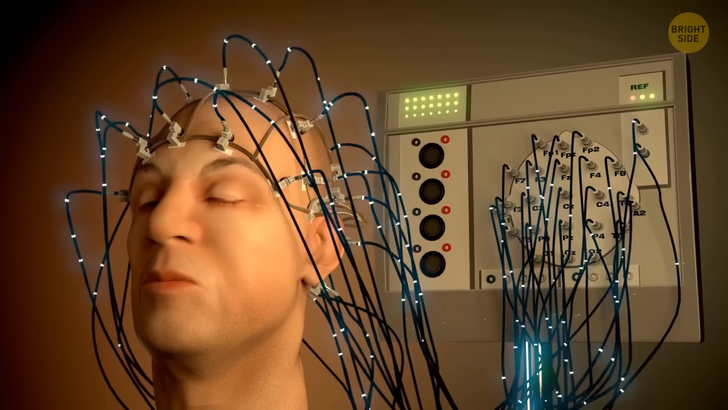I Absolutely Refused to Be the “Office Party Planner” Just Because I’m a Woman


Despite all our differences, we share one thing in common. That’s right, we all feel alive and actively perceive the present, in this very moment. But here’s the catch, my friends — this feeling of “right now” is in fact a little delayed. It takes about half a second for our brains to translate information into our consciences.
If you think about it, technically, the future is already done for, but we’re just not realizing this in due course. And that’s not all — our different senses pick up information each at their own pace, which means our brains have to drag some of them to give us a seamless sense of the present. It’s like our brains are trying to stitch together a Frankenstein monster of sensory information in real-time. And make it look pretty!

But here’s where things get really wild: researchers have found that they can mess with this perception. When that standard delay is removed, our brains get confused, and it gives us the impression that the effect happened before the action that triggered it. It’s like you’d perceive the doorbell sound, but before you’d actually push the button. Weird, right? Why are our brains so easily fooled?
Well, it’s because our conscious minds have a lot of work to do. We have to “translate” the world around us, think about what might happen in the near future, and figure out what to do next. All of that takes time, which is not great when you’re facing fast-moving danger. Imagine a dangerous, wild animal jumps out at you — if you have to consciously think about how to react, you’re done for.
Luckily, our brains have emergency-response “kits” that kick in when we need them most. The startle reflex is the fastest response, triggered by a noise or sudden movement. Within five milliseconds, a lot of muscles are triggered into reacting, and you’re already on the move before you know it. If we have a few more milliseconds, our brains can act in a more interesting way.
The amygdala, our brains’ “first stop shop” for processing emotions, takes about 12 milliseconds to process a threat. It’s not super sophisticated, but it can easily detect danger. In fact, some of our best actions are done without conscious decision-making. Anything we do in less than half a second — like hitting a ball or catching someone’s glance — is done automatically. So, while our conscious minds are great for long-term strategy, some of our best actions are accomplished without it.

But let’s get down to the real question. Thoughts can vary, sure, we all know that because we’ve lived it. Making a difficult career or parenting choice takes a lot more thinking than choosing what to top your ice cream with. But did you ever wonder what the speed of thought is? I mean, do we need a Ferrari to keep up with our brains, or can we simply stick to a bicycle?
Well, some scientists have tackled this tricky question by measuring how quickly we become aware of the information we gather through our senses. Apparently, we can detect stimuli that last as little as 50 milliseconds. That’s about one-twentieth of a second, in case you’re counting.
Now, if we’re talking about sensing and responding, let’s use the sprinter reacting to the starting noise as a benchmark. That’s lightning fast, taking only about 150 milliseconds. However, the speed of our nerve pathways can put a damper on our speedy thoughts. Back in the day, scientists estimated that it took 115 feet per second for information to travel down our nerves.
But thanks to modern research, we now know that some well-insulated nerves can move at up to a whopping 394 feet per second! That’s comparable to a bunch of the world’s fastest cars in the world, like an Aston Martin or a McLaren! When you put it that way, the speed of thought is pretty quick. But don’t worry, you don’t have to train like an Olympian to keep up with your own brain.

You might have even stopped to think about how many thoughts you have in a day. That question counts as a thought, too, you know! Spoiler alert: it’s more than you think! From the moment you wake up to the moment you fall asleep (and maybe even after that), your brain is constantly churning out thoughts.
Some of these thoughts might be simple, like “I need to do laundry” or “I should call my mom.” Others might be more complex, like “What’s the meaning of life?” or “How do we love?”. Believe it or not, a study conducted in 2020 found that the average person has over 6,000 thoughts per day! That’s a lot of thinking. The study used brain scans to track when new thoughts began while participants were either resting or watching a movie.
But not all thoughts are created equal. Some thoughts can make us feel happy and excited, while others can bring us down and cause us to worry. For most people, those negative thoughts can be hard to shake. Also, did you know that your personality can affect how many thoughts you have?
People who are a bit more on the jittery side, tend to have more thoughts than those who are calmer. But don’t worry, having a noisy brain doesn’t automatically mean there’s something wrong with you. Sometimes, our brains can even produce intrusive thoughts that are disturbing or upsetting. While it’s natural to have these kinds of thoughts occasionally, if they’re happening frequently and disrupting your daily routine, it might be worth talking to a professional.

So, where do all these thoughts come from? Your brain’s nerve cells, or neurons, are responsible for communicating with other cells by generating neurotransmitters. This sets off a chain reaction of firing neurons, which then creates thoughts. But what if you want to change your thoughts? It’s possible!
Techniques like mindfulness and working with a trained specialist can help you address unwanted thoughts and give you a more relaxed state of mind. Our brains are somewhat similar to the muscles that help us move around. We can train it to make our lives better... to an extent that is. At the end of the day, it’s not the number of thoughts that matters, but how they affect you and what comes out of them.
Speaking of weird stuff brains can do, some mind-blowing news just hit the scientific community! Researchers have discovered some weird brain waves in octopuses! Yes, you heard that right! These eight-armed wonders feature a type of brain wave we’ve never stumbled upon in the animal kingdom. Now, before you go imagining little octopuses wearing tiny shower caps with electrodes sticking out, let me tell you how this discovery was made.
Scientists surgically attached electrodes to octopuses’ brains and were able to get a glimpse into their thought processes. The amazing project captured the first-ever brain recordings of octopuses that can move around as they please, and the results are mind-bending. The researchers discovered that some of the brain wave patterns are much like some found in the human memory center. This suggests that convergent evolution may be at play here.
What does convergent evolution mean, you might ask? It’s when two different animals end up having the same trait, even though they don’t share a recent common ancestor. Another similar example of convergent evolution is that of dolphins and bats. They both use sound to figure out where they are, but their environment couldn’t be more different.

Octopuses have been considered fascinating by scientists and non-scientists alike. From their remarkable memories to their ability to camouflage themselves, these creatures are nothing short of incredible.
They’ve been known to use objects to solve problems, and they even dream! Yes, you read that right. The color ripples that we can see across their skin as they sleep to show us that they may be dreaming too!
However, octopuses are notoriously difficult to study. They can touch every part of their body with those long arms, which means they have no problem removing whatever tracking objects scientists might have placed on them.











